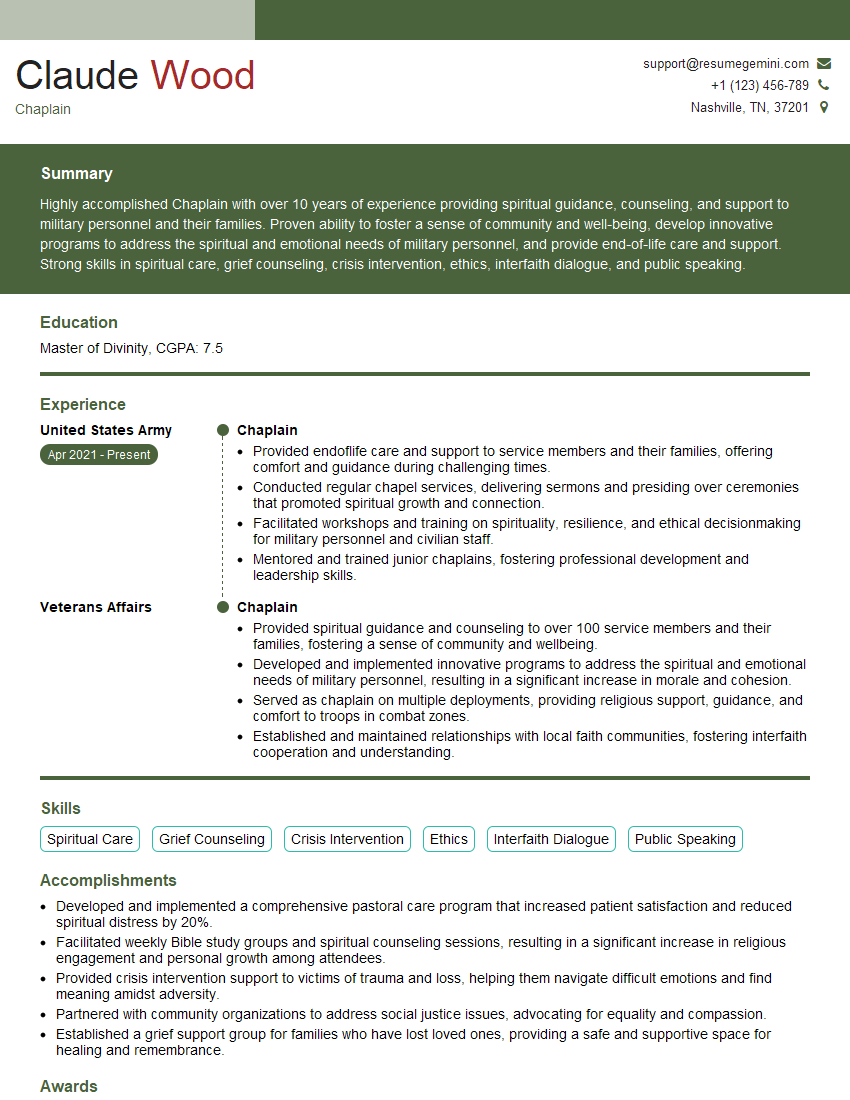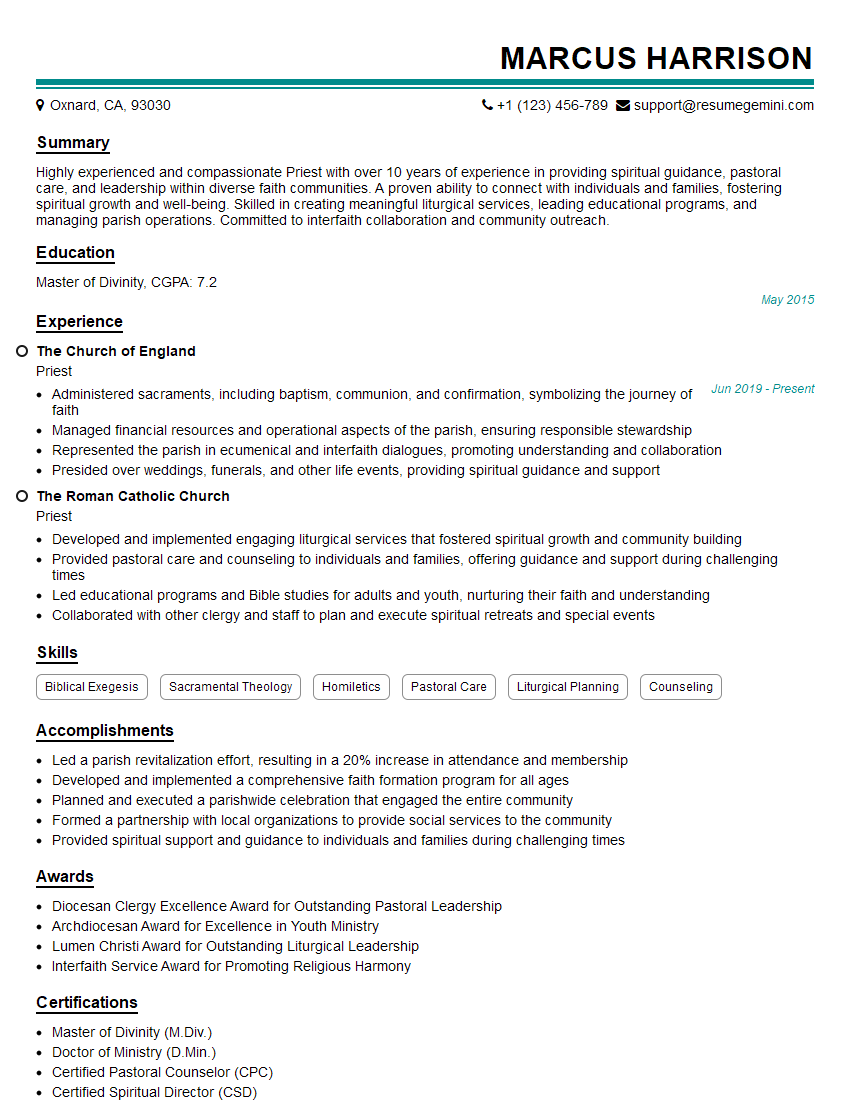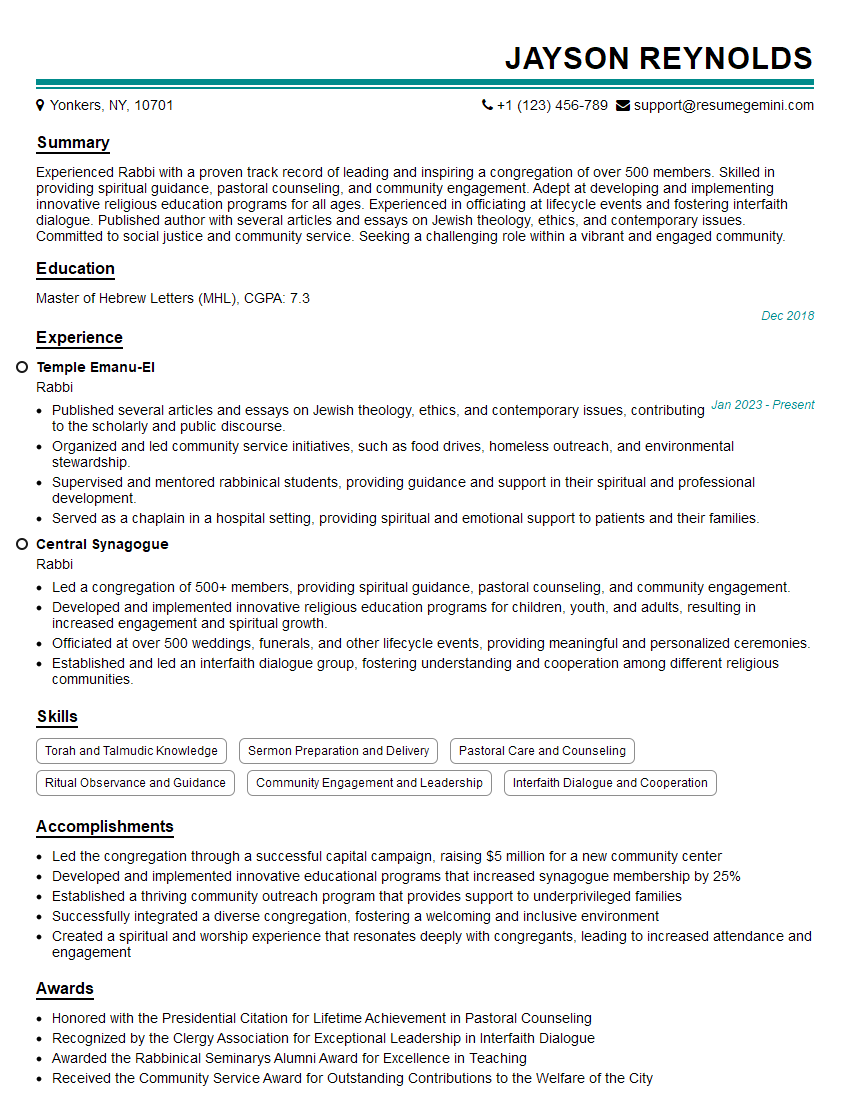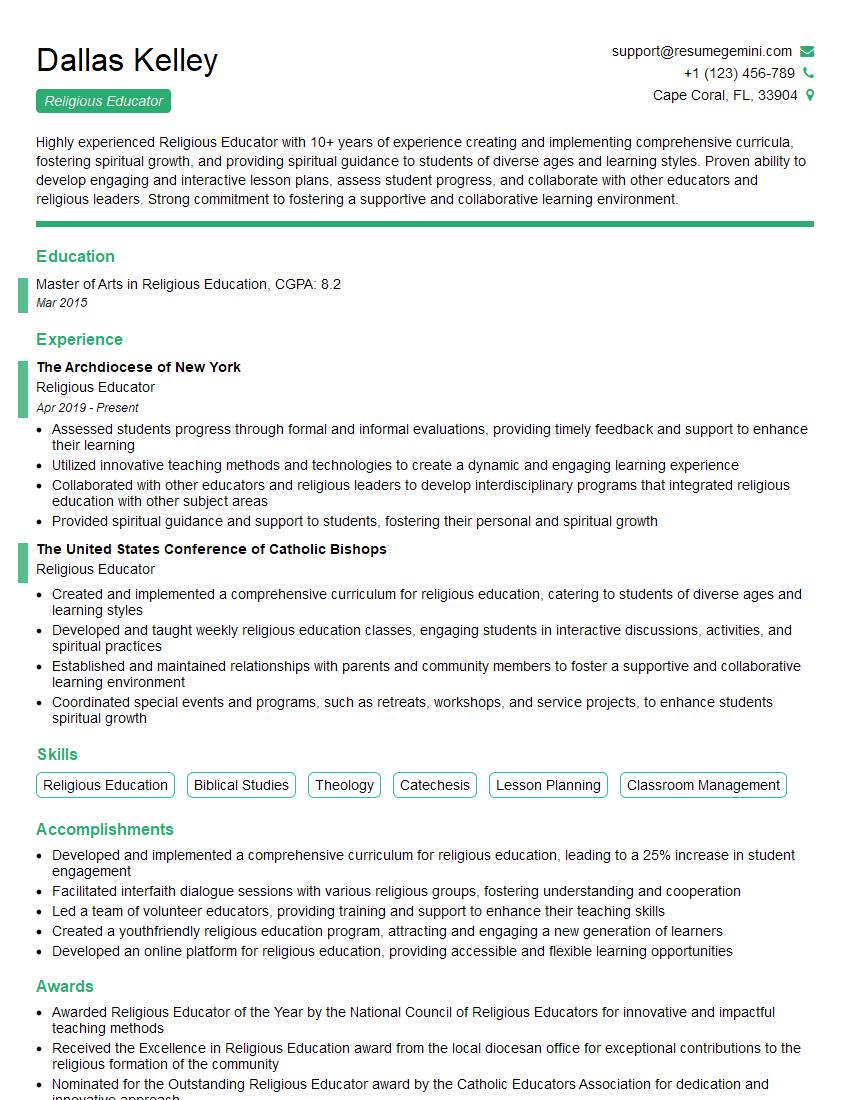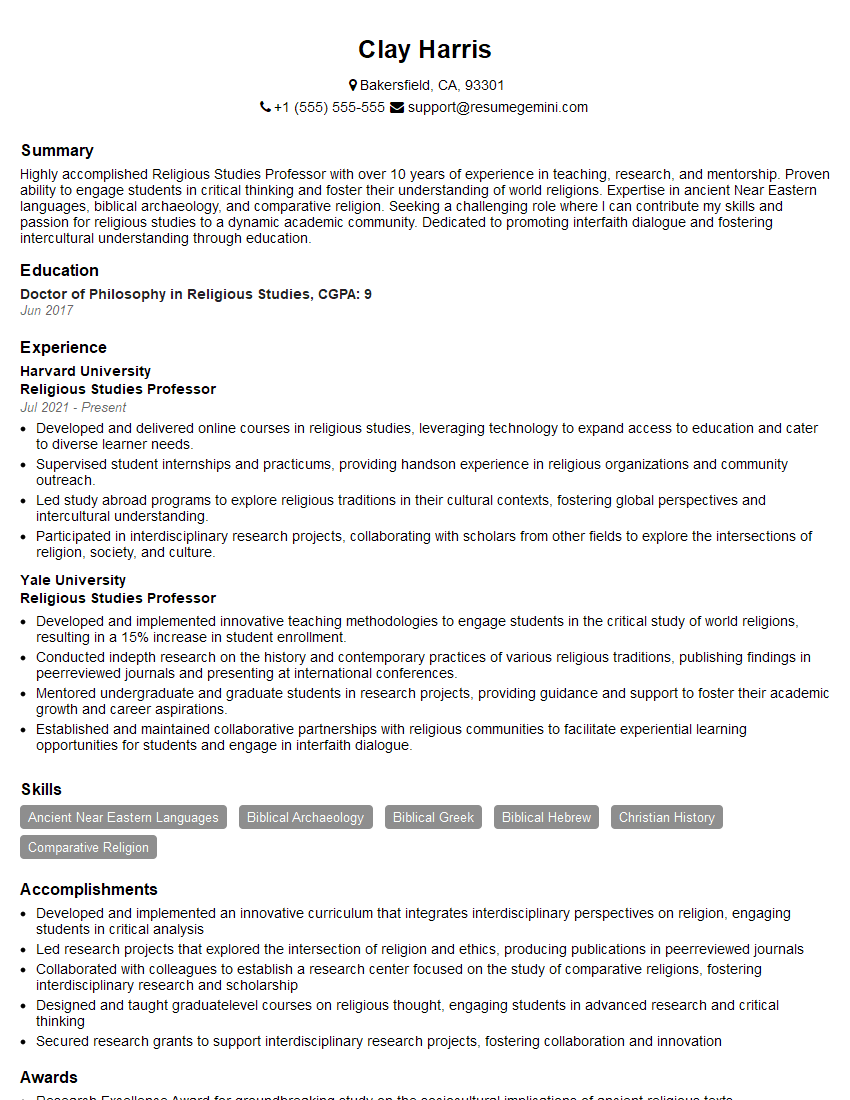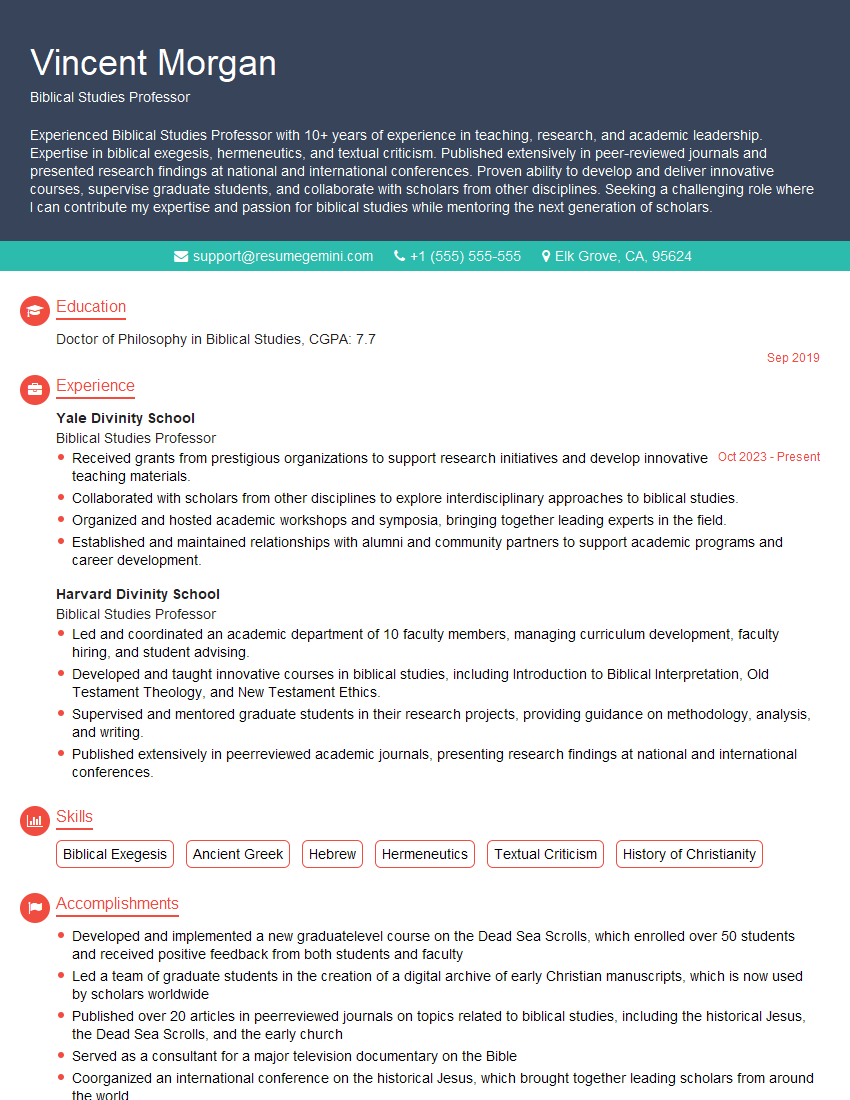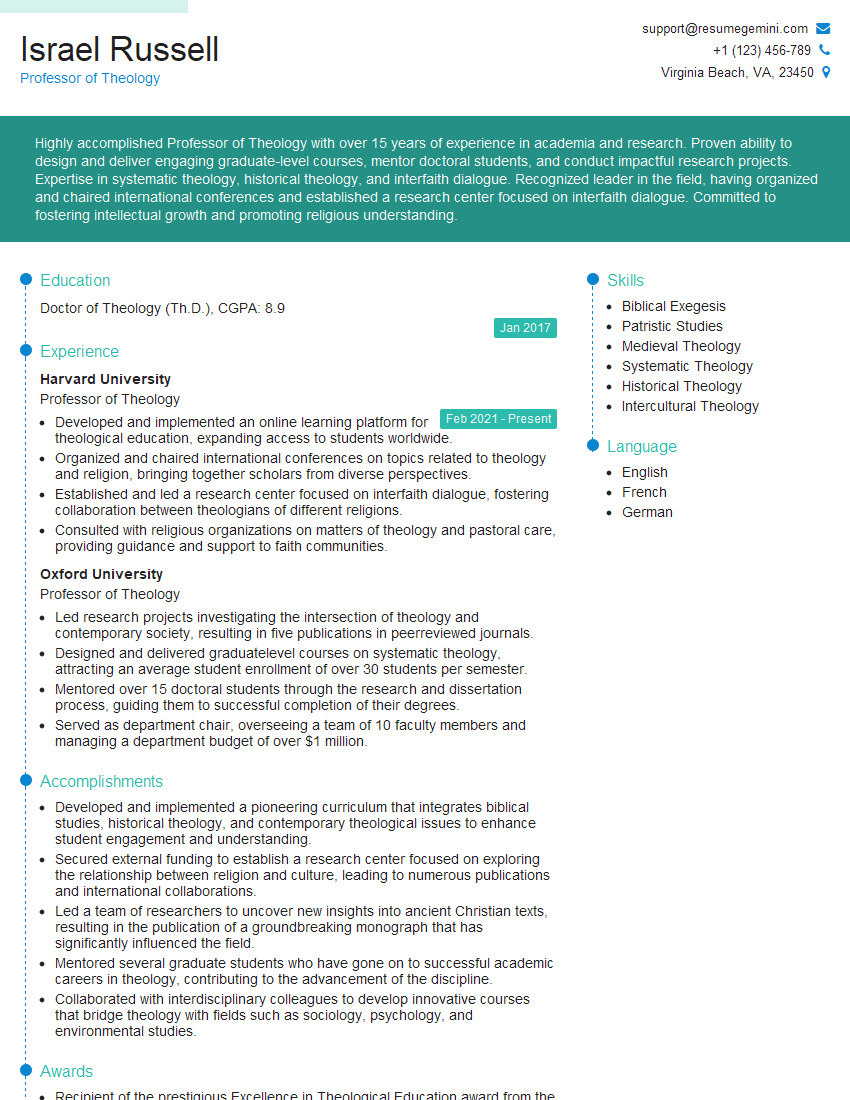Interviews are more than just a Q&A session—they’re a chance to prove your worth. This blog dives into essential Scripture and Biblical Interpretation interview questions and expert tips to help you align your answers with what hiring managers are looking for. Start preparing to shine!
Questions Asked in Scripture and Biblical Interpretation Interview
Q 1. Explain the difference between literal and allegorical interpretation.
Literal interpretation, also known as grammatical-historical interpretation, seeks to understand the text’s meaning as it was originally intended by the author. It emphasizes the historical and literary context, considering the words’ plain meaning and grammatical structure. Allegorical interpretation, on the other hand, goes beyond the literal meaning to find deeper, symbolic meanings. It often sees events, characters, or objects as representing spiritual or theological truths.
For example, the creation account in Genesis 1 can be interpreted literally as a historical account of creation in six days, or allegorically as a representation of God’s power and creative work, with each day symbolizing a different aspect of God’s nature. The key difference lies in whether the focus is on the author’s intended meaning in its historical context (literal) or on uncovering symbolic meanings that may not have been the author’s primary intent (allegorical).
Q 2. Describe your approach to interpreting a difficult or ambiguous passage.
When faced with a difficult or ambiguous passage, I employ a multi-faceted approach. Firstly, I diligently consult various reputable commentaries and scholarly works to understand different perspectives. Then I delve into the historical and cultural context, researching the time period, the author’s background, the intended audience, and the surrounding verses. I pay close attention to the literary genre (e.g., poetry, prophecy, narrative) as this influences how the text should be interpreted. Cross-referencing related passages within the Bible helps to gain a broader understanding. Finally, I prayerfully seek the guidance of the Holy Spirit, acknowledging that the text is divinely inspired and that God can enlighten my understanding. This is a process of careful study, not merely arriving at a conclusion based on a single interpretation.
Q 3. What are the key hermeneutical principles you employ?
My key hermeneutical principles include: grammatical interpretation (understanding the literal meaning of words and grammar); historical interpretation (considering the historical and cultural context); literary interpretation (recognizing the literary genre and style); canonical interpretation (understanding the passage within the broader context of the entire Bible); and theological interpretation (interpreting the passage in light of the overall message of Scripture). I strive for a balanced approach, avoiding both overly literal interpretations that miss the broader meaning and overly allegorical interpretations that impose meanings not supported by the text itself. This is vital to avoid misinterpretations that might lead to incorrect doctrine or application.
Q 4. Compare and contrast different schools of biblical interpretation (e.g., historical-grammatical, reader-response).
The historical-grammatical approach emphasizes the original meaning of the text in its historical context. It seeks to understand the author’s intent by carefully examining the language, grammar, and historical setting. In contrast, the reader-response approach focuses on how the reader interacts with the text and how the text’s meaning is shaped by the reader’s own experiences and perspectives. Other approaches include the canonical approach (understanding the text within the overall context of the Bible) and the narrative approach (examining the story’s structure and plot).
While historical-grammatical seeks to recover the original intended meaning, reader-response acknowledges the role of individual interpretation. It’s important to note that a balanced approach often incorporates elements of various schools of thought; relying solely on one can lead to incomplete or skewed understanding.
Q 5. How do you handle apparent contradictions within Scripture?
Apparent contradictions in Scripture often stem from incomplete understanding or differing perspectives. I approach these by first verifying the accuracy of the translation and ensuring I’m dealing with a genuine discrepancy, not a misinterpretation. Then, I consider the literary context of each passage, literary genre, authorial intent, and historical setting. Sometimes, apparent contradictions resolve when we understand that the Bible utilizes various literary devices (like poetry, parable, etc.). Other times, the differences might reflect different facets of truth or different perspectives on a single event. It’s crucial to remember that the Bible isn’t a single, monolithic work but a collection of books written over centuries, sometimes with differing viewpoints all consistent with a central truth.
Q 6. Discuss the importance of the historical and cultural context in biblical interpretation.
Historical and cultural context are absolutely crucial for accurate biblical interpretation. Understanding the historical period, the customs, beliefs, and social structures of the time helps us grasp the intended meaning of the text. For example, understanding the socio-political context of the Roman Empire is essential for interpreting the Gospels. Ignoring this context can lead to misinterpretations and inaccurate applications. Consider the laws given in the Old Testament: applying them directly today without considering their specific historical and cultural context would be a serious misapplication of scripture.
Q 7. Explain the role of the Holy Spirit in biblical interpretation.
The Holy Spirit plays a vital role in biblical interpretation. While diligent study is essential, ultimately the Holy Spirit illuminates the meaning of Scripture, guiding us to a deeper understanding. The Spirit doesn’t replace diligent study but rather works in conjunction with it. He convicts us of truth, helps us understand the context, and guides us in applying Scripture to our lives. It’s a collaborative process between human effort and divine illumination. Seeking the guidance of the Holy Spirit is not simply a matter of subjective feeling but a prayerful posture of seeking God’s wisdom and guidance as we study His Word.
Q 8. How do you apply biblical principles to contemporary ethical dilemmas?
Applying biblical principles to contemporary ethical dilemmas requires careful hermeneutics—the science of interpretation. We can’t simply pluck verses out of context and apply them directly to modern situations. Instead, we must understand the original meaning within its historical and cultural setting, then discern the underlying principles that transcend time and culture. For example, the commandment “Thou shalt not kill” (Exodus 20:13) isn’t simply about avoiding physical murder; it speaks to a broader principle of respecting the sanctity of human life. This principle can then inform our stance on issues like abortion, capital punishment, and even warfare, prompting us to engage in thoughtful discussion and application considering the nuances of each context.
A helpful approach is to identify the overarching narrative of Scripture—God’s covenant with humanity, marked by love, justice, and mercy. This narrative provides a framework for ethical decision-making. We might ask: How does this decision reflect God’s character? Does it promote shalom (peace and wholeness) for all involved? Does it align with Jesus’ teachings on love and compassion?
For instance, facing a contemporary dilemma like poverty, we can turn to passages emphasizing justice and caring for the poor (e.g., Deuteronomy 15:7-11, Luke 16:19-31). This understanding doesn’t provide a single solution for every situation, but it guides us toward compassionate action and systemic change, working to address root causes.
Q 9. What are some common pitfalls to avoid in biblical interpretation?
Several pitfalls can derail accurate biblical interpretation. One major error is proof-texting—selectively quoting verses out of context to support a predetermined conclusion. This ignores the literary and historical context, leading to misinterpretations. For instance, taking verses about wealth and prosperity out of the Psalms without considering the broader context of lament and faith in a sovereign God can lead to a prosperity gospel that distorts the true message.
Another pitfall is ignoring the literary genre. The Bible employs various genres, including poetry, law, history, prophecy, and apocalyptic literature. Each genre has its own conventions and should be interpreted accordingly. Interpreting a Psalm as literal historical narrative or taking Revelation as a detailed prediction of future events is a misapplication of genre.
Eisegesis, reading our own ideas into the text, is another common mistake. We must strive for exegesis—carefully drawing meaning from the text based on its historical and literary context. This requires considering the author’s intent, the audience, the historical background, and the literary devices used.
Finally, prejudice and bias can unconsciously shape our interpretations. We must approach the text with humility, acknowledging our own biases and seeking to understand the text on its own terms.
Q 10. Analyze the literary genre of a specific biblical book (e.g., Psalms, Proverbs, Revelation).
The Book of Psalms is a collection of 150 poems, spanning various literary forms within the broader category of Hebrew poetry. Understanding this genre is crucial for accurate interpretation. Key characteristics include:
- Parallelism: Ideas are expressed through repeated phrases or lines with slight variations (e.g., “The Lord is my shepherd; I shall not want.”).
- Imagery and Metaphor: Vivid language and imagery are used to convey profound emotions and spiritual truths. These shouldn’t always be taken literally.
- Acrostics: Some psalms use acrostics, where the first letter of each line spells a word or phrase.
- Variety of forms: Different psalm types exist—laments, hymns, praise poems, imprecatory psalms (prayers for justice against enemies)—each with distinct characteristics and literary conventions.
Recognizing that the Psalms are primarily expressions of faith, lament, praise, and prayer, rather than historical narratives or legal codes, allows us to appreciate their emotional depth and spiritual significance. We shouldn’t expect consistency in theological perspectives across all 150 psalms, as different authors wrote them over centuries reflecting diverse experiences and emotions.
Q 11. Explain the significance of a specific biblical character or event.
Joseph, the eleventh son of Jacob, is a pivotal character whose life significantly shapes the biblical narrative. His story, spanning from his early years of favoritism and betrayal to his eventual rise to power in Egypt, embodies several crucial themes. His experience highlights the sovereignty of God, even amidst human cruelty and injustice. Joseph’s suffering and eventual triumph demonstrate God’s ability to use difficult circumstances for his ultimate good and the good of his people.
Joseph’s faithfulness to God despite immense trials, his forgiveness of his brothers who sold him into slavery, and his ultimate act of preserving his family during a devastating famine reveal his integrity and unwavering faith. His story serves as a powerful model of perseverance, forgiveness, and God’s redemptive power. His life also prefigures Jesus’ life, sacrifice, and ultimate triumph over death.
Q 12. Describe the key theological themes of a specific biblical book.
The Gospel of John emphasizes several key theological themes:
- The divinity of Jesus Christ: John consistently portrays Jesus as the incarnate Son of God, equal with the Father. Miracles, claims of divinity, and “I AM” sayings reinforce this central message.
- Eternal Life through faith in Jesus: John highlights the gift of eternal life, attainable through belief in Jesus and his sacrifice. This isn’t merely an afterlife promise but a present reality of spiritual union with God.
- The nature of faith: John explores various aspects of faith, emphasizing trust, obedience, and discipleship. The narratives of specific encounters with Jesus illustrate the transformation that faith brings.
- The Holy Spirit: The role of the Holy Spirit in the life of believers is emphasized, pointing to the ongoing presence and guidance of God after Jesus’ ascension.
- Love: The pervasive theme of God’s love for the world is manifested in Jesus’ sacrifice on the cross. It is a love that calls for response and compels believers to love others.
These themes are interconnected and interwoven throughout John’s narrative, culminating in the affirmation of Jesus as the Messiah, the Son of God, and the way to salvation.
Q 13. Discuss the impact of a specific biblical passage on your life.
Psalm 23, “The Lord is my shepherd,” has profoundly impacted my life. The imagery of a shepherd caring for his flock resonates deeply, providing comfort and assurance during times of uncertainty and struggle. The lines “He restores my soul” and “He leads me in paths of righteousness” speak to the restorative and guiding presence of God in my life.
I find strength in the promise of God’s provision and protection, even in the face of the valley of the shadow of death. This passage reminds me that despite life’s challenges, God is always with me, guiding, protecting, and restoring me. It fosters a sense of peace and trust in God’s unwavering love and care.
Q 14. How do you incorporate different interpretative methods in your work?
I incorporate several interpretative methods in my work, recognizing that no single method provides a complete understanding. My approach is eclectic, drawing upon the strengths of various methods:
- Historical-grammatical: This focuses on understanding the text within its historical and grammatical context. It involves careful attention to the original languages (Hebrew, Aramaic, and Greek), historical background, and literary conventions.
- Literary: This examines the literary structure, style, and genre of the text, recognizing that different genres have different interpretive requirements.
- Canonical: This approach considers the entire biblical canon, understanding individual texts within the larger narrative arc of Scripture.
- Theological: This method seeks to understand the text’s contribution to overarching theological themes and doctrines. It involves engaging with historical and contemporary theological discourse.
By employing these methods in a balanced and nuanced way, I strive to arrive at interpretations that are both faithful to the text and relevant to contemporary life. It’s a process of continuous learning and refinement, recognizing the limitations of human understanding and the complexity of the biblical text.
Q 15. What are the strengths and limitations of using commentaries and other secondary sources?
Commentaries and secondary sources are invaluable tools in biblical interpretation, offering diverse perspectives and scholarly insights. However, they are not without their limitations.
- Strengths: Commentaries provide context, historical background, different interpretations, and can help navigate challenging passages. They often synthesize extensive research, saving the reader significant time. They also expose one to a range of theological viewpoints, broadening understanding.
- Limitations: Commentaries reflect the author’s own biases and theological perspectives. It’s crucial to critically evaluate the author’s methodology, presuppositions, and potential biases. Some commentaries can be overly complex or simplistic, failing to adequately address the nuances of the text. Relying solely on secondary sources can hinder independent critical thinking and personal engagement with the scriptures.
For example, a commentary on the book of Revelation might offer varying interpretations of the symbolic language. Some might adopt a preterist approach, emphasizing historical fulfillment, while others might prefer a futurist or historicist approach. It’s vital to compare different perspectives and engage in thoughtful consideration to arrive at one’s own informed interpretation.
Career Expert Tips:
- Ace those interviews! Prepare effectively by reviewing the Top 50 Most Common Interview Questions on ResumeGemini.
- Navigate your job search with confidence! Explore a wide range of Career Tips on ResumeGemini. Learn about common challenges and recommendations to overcome them.
- Craft the perfect resume! Master the Art of Resume Writing with ResumeGemini’s guide. Showcase your unique qualifications and achievements effectively.
- Don’t miss out on holiday savings! Build your dream resume with ResumeGemini’s ATS optimized templates.
Q 16. How would you explain a complex biblical concept to a layperson?
Explaining complex biblical concepts to a layperson requires clear communication and relatable examples. Let’s take the concept of ‘atonement’ as an example. Atonement refers to the process of reconciliation between God and humanity, broken by sin. Instead of a purely theological explanation, I might use an analogy:
Imagine a broken relationship between two friends. One friend has hurt the other deeply. Atonement would be the process of repairing that relationship, perhaps through apology, forgiveness, and actions demonstrating remorse. In the biblical context, Jesus’s death on the cross is understood as the ultimate act of atonement, bridging the gap between a sinful humanity and a holy God. This allows us to understand atonement not just as a theological doctrine, but as a narrative of restoration and grace.
Q 17. Describe your experience with biblical languages (Hebrew, Greek, Aramaic).
My training includes significant work in Biblical Hebrew and Koine Greek. I’m proficient in reading and translating both languages, which allows me to engage with the original texts directly, rather than relying solely on translations. This provides a deeper understanding of nuances in word choice, grammatical structures, and cultural context. My understanding of Aramaic is more limited, but I can read and understand basic texts. This is particularly helpful when dealing with Aramaic sections within the Old Testament or intertestamental literature. Direct engagement with the original languages is essential for accurate and nuanced interpretation.
Q 18. Explain your understanding of covenant theology.
Covenant theology is a framework for understanding God’s relationship with humanity throughout Scripture. It emphasizes the ongoing nature of God’s promises and commitments, focusing on a series of covenants, or agreements, between God and his people. The most significant covenants include the Abrahamic covenant, the Mosaic covenant (also known as the Sinaitic covenant), and the New Covenant established through Jesus Christ.
These covenants are not merely legal contracts, but expressions of God’s faithful love and grace. The Abrahamic covenant, for instance, promises land, descendants, and blessing to Abraham and his posterity. The Mosaic covenant details God’s law and the stipulations for the Israelites’ relationship with him. The New Covenant, established through Christ’s sacrifice, offers forgiveness of sins and eternal life through faith. Understanding the flow of these covenants provides a framework for interpreting biblical history and God’s plan for redemption.
Q 19. Discuss the concept of inerrancy or infallibility of Scripture.
The concept of inerrancy or infallibility of Scripture is a complex theological issue with various interpretations. Inerrancy, strictly defined, asserts that the Bible, in its original manuscripts, is free from error of any kind, including historical, scientific, and geographical details. Infallibility suggests that the Bible is trustworthy and authoritative in matters of faith and salvation.
Different denominations and theological traditions hold varying views on the extent to which inerrancy applies. The key is to recognize the different literary genres present in the Bible (narrative, poetry, prophecy, law, etc.) and interpret them accordingly. Focusing solely on a literal interpretation without considering literary context can lead to misinterpretations. For example, the creation narrative in Genesis might be best understood as a theological statement about God’s creative act rather than a scientifically detailed account of how the universe was formed. The critical aspect is the Bible’s authority in matters of faith and salvation, which most Christians would affirm, regardless of their view on inerrancy.
Q 20. How do you approach the study of prophecy in Scripture?
Approaching prophecy in Scripture requires careful consideration of various factors. First, recognizing the different types of prophecy is essential. Some prophecies are predictive, foretelling future events, while others are didactic, conveying God’s message and warning to the audience. The context is crucial, considering the historical circumstances, the intended audience, and the immediate message.
Secondly, understanding the literary forms of prophecy, like apocalyptic literature, with its symbolic and visionary language, needs to be considered. Lastly, acknowledging the complexities of fulfillment is important: some prophecies have clear and immediate fulfillments, while others unfold gradually over time or have multiple fulfillments. An example is the prophecies concerning the Messiah in the Old Testament. Many passages point towards aspects of Jesus’s life, death, and resurrection, illustrating both immediate and ongoing fulfillment. Interpreting prophecy requires careful exegesis, hermeneutics, and humility, acknowledging that some aspects of prophecy may remain mysterious.
Q 21. Explain the significance of the biblical canon.
The biblical canon is the collection of books considered authoritative scripture within a particular religious tradition. The process of canonization, spanning centuries, involved careful scrutiny of texts for theological consistency, apostolic authority (in the New Testament), and widespread acceptance within the early Christian church.
The significance of the canon is that it defines the boundaries of authoritative religious teaching and practice. It provides the foundation for Christian faith and theology. Books within the canon are considered inspired by God and provide the ultimate source of religious truth and guidance. The exclusion of other texts from the canon highlights the church’s discernment in determining which writings best reflect God’s revelation. This process helps safeguard the integrity of the faith against heterodox teachings and promotes unity within the Christian community.
Q 22. Discuss the relationship between the Old and New Testaments.
The Old and New Testaments are not two separate books, but two parts of one unified story of God’s redemptive plan for humanity. The Old Testament lays the groundwork, revealing God’s covenant with Abraham, the giving of the Law through Moses, the establishment of Israel as God’s chosen people, and the prophecies foretelling the coming Messiah. Think of it as the ‘promise’ phase. The New Testament fulfills these promises through the life, death, and resurrection of Jesus Christ, the arrival of the promised Messiah. It unveils the establishment of the new covenant, the birth of the church, and the ongoing work of the Holy Spirit. This is the ‘fulfillment’ phase. The relationship is one of promise and fulfillment, foreshadowing and realization. For example, the Passover lamb in Exodus prefigures Jesus, the ultimate sacrificial lamb (John 1:29). The Davidic covenant in 2 Samuel 7 finds its ultimate fulfillment in Jesus, the King of Kings (Matthew 1:1).
Understanding this relationship requires careful study of both testaments, recognizing the continuity of God’s character and purpose throughout. It’s not a simple replacement; the New Testament builds upon and interprets the Old, revealing its deeper meaning in light of Christ.
Q 23. Describe your understanding of the different literary forms within the Bible.
The Bible isn’t a single literary genre; it’s a collection of diverse literary forms, each with its own conventions and interpretive approaches. Recognizing these forms is crucial for accurate interpretation. These include:
- Narrative: Storytelling, conveying events and characters. Examples include the Gospels and the book of Acts.
- Poetry: Expressing ideas and emotions through imagery and symbolism. The Psalms and Proverbs are prime examples. Interpreting poetry requires attention to figurative language and metaphorical expression.
- Law: Prescriptive instructions, often found in Exodus, Leviticus, Deuteronomy. Careful historical and cultural context is needed to understand their application today.
- Prophecy: Messages from God about the future or a judgment on past or present actions. Isaiah, Jeremiah, and Daniel are books full of prophetic literature, which often employs symbolic language and requires careful exegesis.
- Wisdom Literature: Reflecting on life, offering guidance and instruction. Proverbs, Ecclesiastes, and Job exemplify this genre, emphasizing observation and practical application.
- Gospel: Biographical accounts of Jesus’ life, ministry, death, and resurrection. Each Gospel has a unique perspective and theological emphasis.
- Epistles: Letters written to individuals or churches, often addressing specific issues or providing theological instruction. Paul’s letters are the most prominent examples.
- Apocalypse: Revelation unfolds in highly symbolic language, often depicting future events, which requires careful hermeneutical approach.
Understanding the literary form informs how we interpret the text. For example, we wouldn’t interpret a Psalm literally in the same way we would interpret a historical narrative in the book of Kings.
Q 24. How do you balance academic scholarship with personal faith in your interpretation?
Balancing academic scholarship with personal faith is a vital aspect of biblical interpretation. Academic scholarship provides the tools for careful textual analysis, historical context, and literary criticism. It helps us to understand the original meaning and intent of the text. Personal faith, on the other hand, provides the lens through which we engage with the text’s ultimate message. It’s not a matter of choosing one over the other; it’s about integrating both. Think of it like this: scholarship provides the map, while faith provides the destination.
For example, a scholar might use linguistic analysis to understand the nuances of a particular Greek word in the New Testament. But faith informs the understanding of how that word points to the broader message of God’s grace and redemption. It’s a constant interplay, a dialogue between critical analysis and personal conviction, leading to a rich and nuanced understanding of the text.
Q 25. What resources do you use for biblical study and research?
My research utilizes a variety of resources. These include:
- Biblical Texts: Multiple translations in Hebrew, Greek, and various modern languages. Comparing translations helps to see the range of interpretations possible.
- Commentaries: Scholarly works offering in-depth analysis of specific passages or books. I use commentaries from a range of theological perspectives to get a comprehensive understanding.
- Lexicons and Dictionaries: These are essential for understanding the original meaning of words in the Hebrew and Greek texts.
- Historical and Archaeological Resources: Understanding the historical and cultural context of the biblical world enhances interpretation.
- Theological Journals and Books: Keeping up-to-date with current scholarship is crucial. This includes engagement with differing perspectives.
- Software Tools: Software like Logos Bible Software or Accordance provides access to a wide range of biblical and extra-biblical resources, facilitating research.
I also engage in peer review and discussions with other scholars in the field to further refine my understanding and approach.
Q 26. Describe your teaching philosophy regarding biblical interpretation.
My teaching philosophy centers on equipping students to engage with Scripture thoughtfully and critically. I emphasize:
- Grammatical-Historical Interpretation: Understanding the text in its original language and historical context is paramount. This involves a careful analysis of the grammatical structure, vocabulary, and historical setting.
- Literary Context: Recognizing the literary genre and its conventions is essential for accurate interpretation. We shouldn’t interpret poetry as literal history.
- Canonical Context: Understanding how a passage fits within the broader narrative of the entire Bible is crucial. It prevents isolationist readings.
- Cultural Sensitivity: Acknowledging the cultural differences between the biblical world and our own helps us to avoid misinterpretations.
- Hermeneutical Humility: Recognizing the limits of our own understanding and being open to new insights is essential. We shouldn’t claim to have all the answers.
I encourage active participation, critical thinking, and respectful dialogue in my classes, fostering a learning environment where students can develop their own interpretive skills.
Q 27. How do you integrate biblical interpretation into pastoral care or ministry?
Biblical interpretation is integral to pastoral care and ministry. It provides:
- A Foundation for Hope and Encouragement: Scripture offers comfort, guidance, and hope in times of difficulty. I often use relevant passages to point individuals to God’s promises and faithfulness.
- Guidance for Ethical Decision-Making: The Bible provides principles for living a life that honors God and reflects his character. I work with individuals to apply biblical principles to real-life situations.
- Understanding of Human Nature: Scripture’s insights into the human condition help us understand struggles with sin, brokenness, and relationships. This helps me to engage with people with empathy and understanding.
- A Framework for Spiritual Growth: The Bible provides a roadmap for spiritual development, outlining essential practices like prayer, worship, and service to others. I help individuals develop a personal relationship with God.
- Theological Foundation for Preaching and Teaching: Sound biblical interpretation is the bedrock of effective preaching and teaching. My sermons and classes are directly informed by careful engagement with Scripture.
In essence, biblical interpretation informs every aspect of my pastoral ministry, serving as the foundation for my work in caring for and guiding others.
Key Topics to Learn for Scripture and Biblical Interpretation Interview
- Hermeneutical Approaches: Understanding various methods of biblical interpretation (e.g., historical-grammatical, literary, narrative, canonical) and their strengths and weaknesses. Consider how different approaches yield diverse interpretations of the same passage.
- Literary Context: Analyzing the immediate context of a passage (surrounding verses, chapter, book) to understand its meaning within the larger narrative. Practice identifying key literary devices (metaphor, simile, parallelism) and their impact on interpretation.
- Historical-Cultural Context: Researching the historical and cultural background of the biblical text to grasp its original meaning and relevance. Explore how cultural norms and historical events shaped the text’s message.
- Theological Themes: Identifying and explaining recurring theological themes throughout Scripture. Discuss how specific passages contribute to a larger theological framework.
- Exegesis vs. Eisegesis: Differentiating between interpreting the text *from* its own context (exegesis) and imposing one’s own preconceived notions *onto* the text (eisegesis). Be prepared to demonstrate a commitment to objective interpretation.
- Application and Relevance: Articulating the practical application of biblical interpretation to contemporary issues and challenges. Show how biblical principles inform ethical decision-making and spiritual growth.
- Interpretative Challenges and Problem-Solving: Analyzing passages with apparent contradictions or difficulties. Demonstrate the ability to thoughtfully engage with challenging texts and offer well-reasoned interpretations.
- Specific Biblical Genres: Demonstrate understanding of different genres (poetry, prophecy, law, narrative, gospel, epistle) and how their unique features impact interpretation.
Next Steps
Mastering Scripture and Biblical Interpretation is crucial for career advancement in ministry, theological education, and related fields. A strong understanding of these principles demonstrates your commitment to careful scholarship and thoughtful engagement with the text. To enhance your job prospects, it’s vital to create a professional, ATS-friendly resume that effectively highlights your skills and experience. We highly recommend using ResumeGemini to build a compelling resume tailored to your specific career goals. ResumeGemini offers a user-friendly platform and provides examples of resumes tailored to Scripture and Biblical Interpretation to help you create a document that truly showcases your qualifications.
Explore more articles
Users Rating of Our Blogs
Share Your Experience
We value your feedback! Please rate our content and share your thoughts (optional).
What Readers Say About Our Blog
Hello,
We found issues with your domain’s email setup that may be sending your messages to spam or blocking them completely. InboxShield Mini shows you how to fix it in minutes — no tech skills required.
Scan your domain now for details: https://inboxshield-mini.com/
— Adam @ InboxShield Mini
Reply STOP to unsubscribe
Hi, are you owner of interviewgemini.com? What if I told you I could help you find extra time in your schedule, reconnect with leads you didn’t even realize you missed, and bring in more “I want to work with you” conversations, without increasing your ad spend or hiring a full-time employee?
All with a flexible, budget-friendly service that could easily pay for itself. Sounds good?
Would it be nice to jump on a quick 10-minute call so I can show you exactly how we make this work?
Best,
Hapei
Marketing Director
Hey, I know you’re the owner of interviewgemini.com. I’ll be quick.
Fundraising for your business is tough and time-consuming. We make it easier by guaranteeing two private investor meetings each month, for six months. No demos, no pitch events – just direct introductions to active investors matched to your startup.
If youR17;re raising, this could help you build real momentum. Want me to send more info?
Hi, I represent an SEO company that specialises in getting you AI citations and higher rankings on Google. I’d like to offer you a 100% free SEO audit for your website. Would you be interested?
Hi, I represent an SEO company that specialises in getting you AI citations and higher rankings on Google. I’d like to offer you a 100% free SEO audit for your website. Would you be interested?
good
